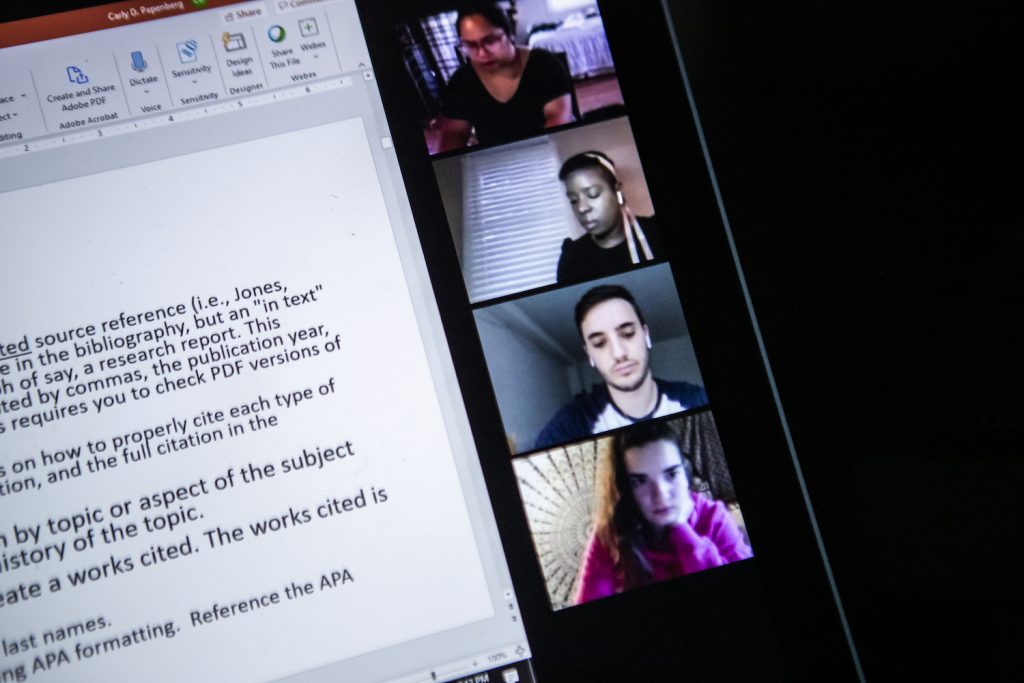The push toward online instruction has been accelerated by the onset of COVID-19, sending both students and faculty into Zoom rooms and other online environments. This moment created something of an identity crisis for universities, whose faculty were required to pivot and clear unexpected technological hurdles, discovering new ways of connecting with students in real-time.
Amy Lavin, assistant professor and academic director for Master of Digital Innovation in Marketing, and Sheri Lambert, assistant professor and academic director for the Master of Market Research & Insights, recently published an article discussing this pivotal moment in educational brand management. Their study, titled “Higher Education: Differentiating through academic innovation and student engagement in challenging times,” was published in the summer issue of the Journal of Education Advancement & Marketing.
“Technology is no longer a barrier for entry,” says Lavin. “It now enables connections; we just have to learn how to make it happen.”
The article combines observations and insights from the professors’ collected experience coupled with recent research on the subject. They propose three key strategies for maintaining enrollment and building on brand reputation: innovating online education experiences with immersive tools and technology, providing rich engagement for students with faculty and demonstrating the persistence of a university’s brand value for prospective students.
Lavin’s research in digital innovation and a decade of teaching courses online made her a good match for Lambert’s expertise in the world of marketing. The unique perspectives each person brought to the research opened a conversation about branding the value of an online learning experience.
“We’ve got years of corporate experience working with teams and clients,” says Lavin. “Both of us have brought that experience over into teaching in the classroom.”
In the article, Lambert discusses her decision to lead immersive study-abroad experiences online rather than around the world.
“Our ability to take students abroad internationally for immersions was gone due to the pandemic,” says Lambert. “For me, a way to differentiate our institution was to take students, internationally, through virtual country immersions.”
Lambert found ways to continue offering a study-abroad course by collaborating with colleagues across disciplines in the Fox School to create an immersive online experience in which students “traveled” to Cairo, Egypt. From virtual museum tours and company meetings to cultural snacks and belly dancing lessons, the Fox Without Borders program brought students an authentic international experience through their computer screens.
“It’s about making synchronous experiences more engaging because the technology is there to do so,” says Lambert.
Lambert actively engages students in her more traditional virtual class settings as well. Instead of standing or sitting in place while lecturing, she prefers to get up and walk around while she speaks. She even prepared a range of applause clips to play after student presentations.
“You have to approach teaching virtually very differently,” says Lambert. “You can’t just stand in a lecture hall and speak to the room in the hopes that people at home are paying attention. We wanted to engage them with the content, so even though they’re not in the same physical room with you, they can feel connected with other students.”
Their article suggests that when done well, online content can be as engaging as their in-person counterparts. In some cases, they even say that it may provide even more engaging experiences than traditional lectures.
“I think it’s more engaging; students can’t hide because there is no back row,” says Lambert.
These findings challenge the long-held belief that traditional learning environments are the most effective. By embracing these changes and leaning into delivering fulfilling online experiences, universities have a new opportunity to differentiate themselves from the competition.
Lambert and Lavin hope that the article could help to inform both educators and academic administrators. They aim to show that institutions are in a position to fund training and resources to support educators’ transition to online instruction.
“People are now used to being at home, and are comfortable with the new work/life balances that they have,” says Lavin. “COVID-19 isn’t gone. I think there’s a lot of opportunity to do things online.”
With a better grasp on available technologies, educators can better deliver an institution’s brand of value by engaging with students online in an enriching way. The colleges that will succeed are those that are willing to invest in developing engaging experiences for both virtual classrooms and virtual campuses.
